Population Parameters and Growth of Riptortus pedestris (Fabricius) (Hemiptera: Alydidae) under Fluctuating Temperature
Abstract
Simple Summary
Abstract
1. Introduction
2. Materials and Methods
2.1. Insect Maintenance
2.2. Laboratory Experiment
2.3. Life Table Data Analysis
2.4. Population Projection
3. Results
4. Discussion
5. Conclusions
Supplementary Materials
Author Contributions
Funding
Institutional Review Board Statement
Data Availability Statement
Acknowledgments
Conflicts of Interest
References
- Visalakshi, A.; Jacob, A.; Nair, M.R.G.K. Biology of Riptortus pedestris F. (Coreidae: Hemiptera), a pest of cow-pea. Entomon 1976, 1, 139–142. [Google Scholar]
- Kono, S. Analysis of soybean seed injuries caused by three species of stink bugs. Jpn. J. Appl. Entomol. Zool. 1989, 33, 128–133. [Google Scholar] [CrossRef]
- Leal, W.S.; Higuchi, H.; Mizutani, N.; Nakamori, H.; Kadosawa, T.; Ono, M. Multifunctional communication in Riptortus clavatus (Heteroptera: Alydidae): Conspecific nymphs and egg parasitoid Ooencyrtus nezarae use the same adult attractant pheromone as chemical cue. J. Chem. Ecol. 1995, 21, 973–985. [Google Scholar] [CrossRef] [PubMed]
- Lim, U.T. Occurrence and Control Method of Riptortus pedestris (Hemiptera: Alydidae): Korean Perspectives. Korean J. Appl. Entomol. 2013, 52, 437–448. [Google Scholar] [CrossRef]
- Li, K.; Zhang, X.; Guo, J.; Penn, H.; Wu, T.; Li, L.; Jiang, H.; Chang, L.; Wu, C.; Han, T. Feeding of Riptortus pedestris on soybean plants, the primary cause of soybean staygreen syndrome in the Huang-Huai-Hai river basin. Crop J. 2019, 7, 360–367. [Google Scholar] [CrossRef]
- Harris, R.M.B.; Beaumont, L.J.; Vance, T.R.; Tozer, C.R.; Remenyi, T.; Perkins-Kirkpatrick, S.E.; Mitchell, P.J.; Nicotra, A.B.; McGregor, S.; Andrew, N.R.; et al. Biological responses to the press and pulse of climate trends and extreme events. Nat. Clim. Chang. 2018, 8, 579–587. [Google Scholar] [CrossRef]
- Jactel, H.; Koricheva, J.; Castagneyrol, B. Responses of forest insect pests to climate change: Not so simple. Curr. Opin. Insect Sci. 2019, 35, 103–108. [Google Scholar] [CrossRef]
- Lehmann, P.; Ammunét, T.; Barton, M.; Battisti, A.; Eigenbrode, S.D.; Jepsen, J.U.; Kalinkat, G.; Neuvonen, S.; Niemelä, P.; Terblanche, J.S.; et al. Complex responses of global insect pests to climate warming. Front. Ecol. Environ. 2020, 18, 141–150. [Google Scholar] [CrossRef]
- Aguila, L.C.R.; Hussain, M.; Huang, W.; Lei, L.; Bamisile, B.S.; Wang, F.; Chi, H.; Wang, L. Temperature-dependent demography and population projection of Tamarixia radiata (Hymenoptera: Eulophidea) reared on Diaphorina citri (Hemiptera: Liviidae). J. Econ. Entomol. 2019, 113, 55–63. [Google Scholar]
- Ahn, J.J.; Choi, K.S.; Koh, S. Effects of temperature on the development, fecundity, and life table parameters of Riptortus pedestris (Hemiptera: Alydidae). Appl. Entomol. Zool. 2019, 54, 63–74. [Google Scholar] [CrossRef]
- Colinet, H.; Sinclair, B.J.; Vernon, P.; Renault, D. Insects in Fluctuating Thermal Environments. Annu. Rev. Entomol. 2015, 60, 123–140. [Google Scholar] [CrossRef]
- Cui, J.; Zhu, S.-Y.; Bi, R.; Xu, W.; Gao, Y.; Shi, S.-S. Effect of temperature on the development, survival, and fecundity of Heliothis viriplaca (Lepidoptera: Noctuidae). J. Econ. Entomol. 2018, 111, 1940–1946. [Google Scholar] [CrossRef]
- Govindan, B.N.; Hutchinson, W.D. Influence of temperature on age-stage, two-sex life tables for a Minnesota-acclimated population of the brown marmorated stink bug (Halyomorpha halys). Insects 2020, 11, 108. [Google Scholar] [CrossRef]
- Nelson, W.A.; Bjørnstad, O.N.; Yamanaka, T. Recurrent Insect Outbreaks Caused by Temperature-Driven Changes in System Stability. Science 2013, 341, 796–799. [Google Scholar] [CrossRef]
- Nooten, S.S.; Andrew, N.R.; Hughes, L. Potential Impacts of Climate Change on Insect Communities: A Transplant Experiment. PLoS ONE 2014, 9, e85987. [Google Scholar] [CrossRef]
- Ruel, J.J.; Ayres, M.P. Jensen′s inequality predicts effects of environmental variation. Trends Ecol. Evol. 1999, 14, 361–366. [Google Scholar] [CrossRef]
- Wu, T.-H.; Shiao, S.-F.; Okuyama, T. Development of insects under fluctuating temperature: A review and case study. J. Appl. Entomol. 2015, 139, 592–599. [Google Scholar] [CrossRef]
- Chi, H.; Su, H.-Y. Age-stage, two-sex life tables of Aphidius gifuensis (Ashmead) (Hymenoptera: Braconidae) and its host Myzus persicae (Sulzer) (Homoptera: Aphididae) with mathematical proof of the relationship between female fecundity and the net reproductive rate. Environ. Entomol. 2006, 35, 10–21. [Google Scholar] [CrossRef]
- Huang, Y.-B.; Chi, H. Age-stage, two-sex life tables of Bactrocera cucurbitae (Coquillett) (Diptera: Tephritidae) with a discussion on the problem of applying female age-specific life tables to insect populations. Insect Sci. 2012, 19, 263–273. [Google Scholar] [CrossRef]
- Akca, I.; Ayvaz, T.; Yazici, E.; Smith, C.L.; Chi, H. Demography and population projection of Aphis fabae (Hemiptera: Aphididae): With additional comments on life table research criteria. J. Econ. Entomol. 2015, 108, 1466–1478. [Google Scholar] [CrossRef]
- Chen, G.-M.; Chi, H.; Wang, R.-C.; Wang, Y.-P.; Xu, Y.-Y.; Li, X.-D.; Yin, P.; Zheng, F.-Q. Demography and uncertainty of population growth of Conogethes punctiferalis (Lepidoptera: Crambidae) reared on five host plants with discussion on some life history statistics. J. Econ. Entomol. 2018, 111, 2143–2152. [Google Scholar] [CrossRef]
- Huang, K.Y.-B.; Atlihan, R.; Gökçe, A.; Huang, J.Y.-B.; Chi, H. Demographic Analysis of Sex Ratio on Population Growth of Bactrocera dorsalis (Diptera: Tephritidae) With Discussion of Control Efficacy Using Male Annihilation. J. Econ. Entomol. 2016, 109, 2249–2258. [Google Scholar] [CrossRef]
- Shi, M.-Z.; Li, J.-Y.; Ding, B.; Fu, J.-W.; Zheng, L.-Z.; Chi, H. Indirect effect of elevated CO2 on population parameters and growth of Agasicles hygrophila (Coleoptera: Chrysomelidae), a biological agent of alligatorweed (Amaranthaceae). J. Econ. Entomol. 2019, 112, 1120–1129. [Google Scholar] [CrossRef]
- Tang, Q.; Ma, K.; Chi, H.; Hou, Y.; Gao, X. Transgenerational hermetic effects of sublethal dose of flupyradi-furone on the green peach aphid, Myzus persicae (Sulzer) (Hemiptera: Aphididae). PLoS ONE 2019, 14, e0208058. [Google Scholar] [CrossRef] [PubMed]
- Chi, H.; You, M.; Atlihan, R.; Smith, C.L.; Kavousi, A.; Özgökçe, M.S.; Güncan, A.; Tuan, S.-J.; Fu, J.-W.; Xu, Y.-Y.; et al. Age-stage, two-sex life table: An introduction to theory, data analysis, and application. Entomol. Gen. 2020, 40, 103–124. [Google Scholar] [CrossRef]
- Kim, H.; Baek, S.; Kim, S.; Lee, S.-Y.; Lee, J.-H. Temperature-dependent development and oviposition models of Riptortus clavatus (Thunberg) (Hemiptera: Alydidae). Appl. Entomol. Zool. 2009, 44, 515–523. [Google Scholar] [CrossRef]
- Rahman, M.M.; Lim, U.T. Evaluation of mature soybean pods as a food source for two pod-sucking bugs, Riptortus pedestris (Hemiptera: Alydidae) and Halyomorpha halys (Hemiptera: Pentatomidae). PLoS ONE 2017, 12, e0176187. [Google Scholar] [CrossRef]
- Maia, A.H.N.; Luiz, A.J.B.; Campanhola, C. Statistical inference on associated fertility life table parameters using jackknife technique: Computational aspects. J. Econ. Entomol. 2000, 93, 511–518. [Google Scholar] [CrossRef]
- Cloudsley-Thompson, J.L. The significance of fluctuating temperatures on the physiology and ecology of insects. Entomologist 1953, 86, 183–189. [Google Scholar]
- Economos, A.C.; Lints, F.A. Developmental temperature and life span in Drosophila melanogaster. II. Oscillating temperature. Gerontology 1986, 32, 28–36. [Google Scholar] [CrossRef] [PubMed]
- Fischer, K.; Kölzow, N.; Höltje, H.; Karl, I. Assay conditions in laboratory experiments: Is the use of constant rather than fluctuating temperatures justified when investigating temperature induced plasticity? Oecologia 2011, 166, 23–33. [Google Scholar] [CrossRef]
- Kingsolver, J.G.; Ragland, G.J.; Diamond, S.E. Evolution in a constant environment: Thermal fluctuations and thermal sensitivity of laboratory and field populations of Manduca sexta. Evolution 2009, 63, 537–541. [Google Scholar] [CrossRef]
- Kjarsgaard, A.; Pertoldi, C.; Loeschcke, V.; Blanckenhorn, W.U. The effect of fluctuating temperatures during development on fitness-related traits of Scatophaga stercoraria (Diptera: Scathophagidae). Environ. Entomol. 2013, 42, 1069–1078. [Google Scholar] [CrossRef]
- McCalla, K.A.; Keçeci, M.; Milosavijević, I.; Ratkowsky, D.A.; Hoddle, M.A. The influence of temperature variation on life history parameters and thermal performance curves of Tamarixia radiata (Hymenoptera: Eulophidae), a parasitoid of the Asian citrus psyllid (Hemiptera: Liviidae). J. Econ. Entomol. 2019, 112, 1560–1574. [Google Scholar] [CrossRef]
- Milosavijević, I.; McCalla, K.A.; Ratkowsky, D.A.; Hoddle, M.A. Effects of constant and fluctuating temperatures on development rates and longevity of Diaphorencyrtus aligarhensis (Hymenoptera: Encyrtidae). J. Econ. Entomol. 2019, 112, 1062–1072. [Google Scholar] [CrossRef]
- Chi, H.; Liu, H. Two new methods for the study of insect population ecology. Bull. Inst. Zool. Acad. Sin. 1985, 24, 225–240. [Google Scholar]
- Chi, H. Life-Table Analysis Incorporating Both Sexes and Variable Development Rates Among Individuals. Environ. Entomol. 1988, 17, 26–34. [Google Scholar] [CrossRef]
- Chi, H. TWOSEX-MSChart: A Computer Program for the Age-Stage, Two-Sex Life Table Analysis 2020. Available online: http://140.120.197.173/Ecology/Download/Twosex-MSChart.exe-B100000.rar (accessed on 20 January 2020).
- Goodman, D. Optimal Life Histories, Optimal Notation, and the Value of Reproductive Value. Am. Nat. 1982, 119, 803–823. [Google Scholar] [CrossRef]
- Tuan, S.J.; Lee, C.C.; Chi, H. Population and damage projection of Spodoptera litura (F.) on peanuts (Arachis hypogaea L.) under different conditions using the age-stage, two-sex life table. Pest. Manage. Sci. 2014, 70, 805–813. [Google Scholar] [CrossRef]
- Efron, B.; Tibshirani, R.J. An Introduction to the Bootstrap; Chapman & Hall: New York, NY, USA, 1993. [Google Scholar]
- Chi, H. TIMING-MSChart: A Computer Program for the Population Projection Based on Age-Stage, Two-Sex Life Table 2020. Available online: http://140.120.197.173/Ecology/Download/Timing-MSChart.rar (accessed on 20 January 2020).
- Brakefield, P.M.; Mazzotta, V. Matching field and laboratory environments: Effects of neglecting daily temperature variation on insect reaction norms. J. Evol. Biol. 1995, 8, 559–573. [Google Scholar] [CrossRef]
- Mironidis, G.K.; Savopoulou-Soultani, M. Development, survivorship, and reproduction of Helicoverpa armigera (Lepidoptera: Noctuidae) under constant and alternating temperatures. Environ. Entomol. 2008, 37, 16–28. [Google Scholar] [CrossRef] [PubMed]
- Vangansbeke, D.; De Schrijver, L.; Spranghers, T.; Audenaert, J.; Verhoeven, R.; Nguyen, D.T.; Gobin, B.; Tirry, L.; De Clercq, P. Alternating temperatures affect life table parameters of Phytoseiulus persimilis, Neoseiulus californicus (Acari: Phytoseiidae) and their prey Tetranychus urticae (Acari: Tetranychidae). Exp. Appl. Acarol. 2013, 61, 285–298. [Google Scholar] [CrossRef]
- Cheng, L.-Y.; Chang, Y.; Chen, Z.-Z.; Xu, Y.-Y. Effects of constant and fluctuating temperatures on development and reproduction of Megoura crassicauda and Aphis craccivora (Hemiptera: Aphididae). Entomol. Fenn. 2018, 29, 1–12. [Google Scholar] [CrossRef][Green Version]
- Bannerman, J.A.; Gillespie, D.R.; Roitberg, B.D. The impacts of extreme and fluctuating temperatures on trait-mediated indirect aphid-parasitoid interactions. Ecol. Entomol. 2011, 36, 490–498. [Google Scholar] [CrossRef]
- Kingsolver, J.G.; Buckley, L.B. Quantifying thermal extremes and biological variation to predict evolutionary responses to changing climate. Philos. T. Roy. Soc. B. 2017, 372, 20160147. [Google Scholar] [CrossRef]
- Vasseur, D.A.; DeLong, J.P.; Gilbert, B.; Greig, H.S.; Harley, C.D.G.; McCann, K.S.; Savage, V.; Tunney, T.D.; O′Connor, M.I. Increased temperature variation poses a greater risk to species than climate warming. P. Roy. Soc. B Biol. Sci. 2014, 281, 20132612. [Google Scholar] [CrossRef]
- Williams, C.M.; Buckley, L.B.; Sheldon, K.S.; Vickers, M.; Pörtner, H.-O.; Dowd, W.W.; Gunderson, A.R.; Marshall, K.E.; Stillman, J.H. Biological Impacts of Thermal Extremes: Mechanisms and Costs of Functional Responses Matter. Integr. Comp. Biol. 2016, 56, 73–84. [Google Scholar] [CrossRef] [PubMed]
- Chidawanyika, F.; Mudavanhu, P.; Nyamukondiwa, C. Global Climate Change as a Driver of Bottom-Up and Top-Down Factors in Agricultural Landscapes and the Fate of Host-Parasitoid Interactions. Front. Ecol. Evol. 2019, 7, 80. [Google Scholar] [CrossRef]
- Mutamiswa, R.; Machekano, H.; Chidawanyika, F.; Nyamukondiwa, C. Life-stage related responses to combined effects of acclimation temperature and humidity on the thermal tolerance of Chilo partellus (Swinhoe) (Lepidoptera: Crambidae). J. Therm. Biol. 2019, 79, 85–94. [Google Scholar] [CrossRef]
- Stephens, A.E.A.; Kriticos, D.J.; Leriche, A. The current and future potential geographical distribution of the oriental fruit fly, Bactrocera dorsalis (Diptera: Tephritidae). Bull. Entomol. Res. 2007, 97, 369–378. [Google Scholar] [CrossRef]
- Bahar, M.H.; Soroka, J.J.; Dosdall, L.M. Constant versus fluctuating temperatures in the interactions between Plutella xylostella (Lepidoptera: Plutellidae) and its larval parasitoid Diadegma insulare (Hymenoptera: Ich-neumonidae). Environ. Entomol. 2012, 41, 1653–1661. [Google Scholar] [CrossRef] [PubMed]
- Simmons, A.M. Effects of Constant and Fluctuating Temperatures and Humidities on the Survival of Spodoptera frugiperda Pupae (Lepidoptera: Noctuidae). Fla. Entomol. 1993, 76, 333. [Google Scholar] [CrossRef]
- Siddiqui, W.H.; Barlow, C.A. Population Growth of Anagasta kuehniella (Lepidoptera: Pyralidae) at Constant and Alternating Temperatures. Ann. Entomol. Soc. Am. 1972, 66, 579–585. [Google Scholar] [CrossRef]
- Hagstrum, D.W.; Leach, C.E. Role of Constant and Fluctuating Temperatures in Determining Development Time and Fecundity of Three Species of Stored-Products Coleoptera. Ann. Entomol. Soc. Am. 1973, 66, 407–410. [Google Scholar] [CrossRef]
- Birch, L.C. The Intrinsic Rate of Natural Increase of an Insect Population. J. Anim. Ecol. 1948, 17, 15. [Google Scholar] [CrossRef]
- Ahn, J.J.; Choi, K.S.; Koh, S. Population parameters and growth of Riptortus pedestris (Fabricius) (Hemiptera: Alydidae) under elevated CO2 concentrations. Entomol. Res. 2021, 51, 12–23. [Google Scholar] [CrossRef]
- Ahn, J.J.; Cho, J.R.; Kim, J.-W.; Seo, B.Y. Thermal effects on the population parameters and growth of Acrythosi-phon pisum (Harris) (Hemiptera: Aphididae). Insects 2020, 11, 481. [Google Scholar] [CrossRef]
- Seo, B.Y.; Kim, E.Y.; Ahn, J.J.; Kim, Y.; Kang, S.; Jung, J.K. Development, Reproduction, and Life Table Parameters of the Foxglove Aphid, Aulacorthum solani Kaltenbach (Hemiptera: Aphididae), on Soybean at Constant Temperatures. Insects 2020, 11, 296. [Google Scholar] [CrossRef]
- Ali, M.Y.; Naseem, T.; Arshad, M.; Ashraf, I.; Rizwan, M.; Tahir, M.; Rizwan, M.; Sayed, S.; Ullah, M.I.; Khan, R.R.; et al. Host-plant variation affect the biotic potential, survival, and population projection of Myzus persicae (Hemiptera: Aphididae). Insects 2021, 12, 375. [Google Scholar] [CrossRef]
- Wang, T.; Ren, Y.-L.; Tian, T.-A.; Li, Z.-T.; Wang, X.-N.; Wu, Z.-Y.; Tang, J.; Liu, J.-F. Determining the Effect of Temperature on the Growth and Reproduction of Lasioderma serricorne Using Two-Sex Life Table Analysis. Insects 2021, 12, 1103. [Google Scholar] [CrossRef]
- Rismayani, R.; Ullah, M.S.; Chi, H.; Gotoh, T. Impact of Constant and Fluctuating Temperatures on Population Characteristics of Tetranychus pacificus (Acari: Tetranychidae). J. Econ. Entomol. 2021, 114, 638–651. [Google Scholar] [CrossRef]
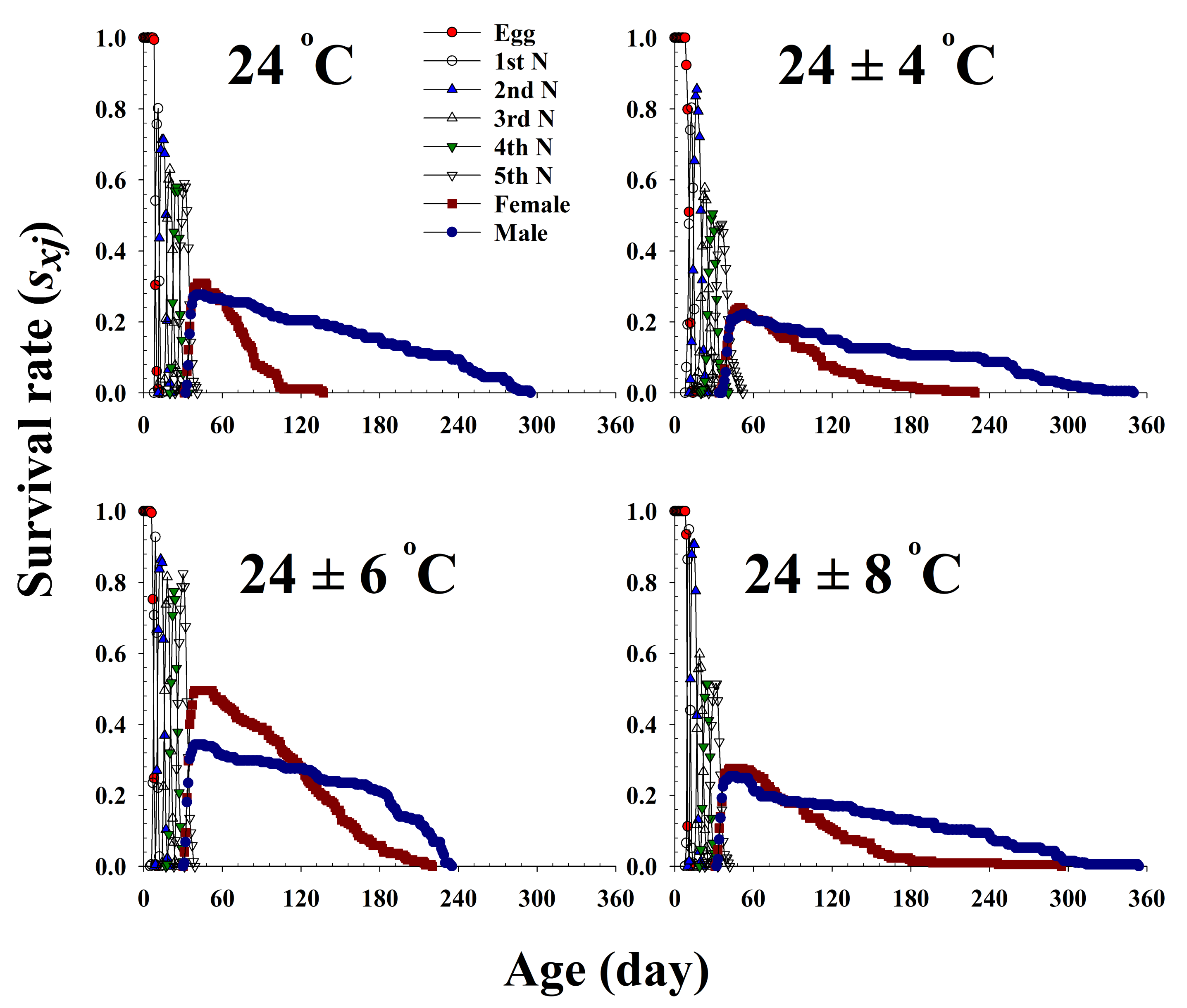
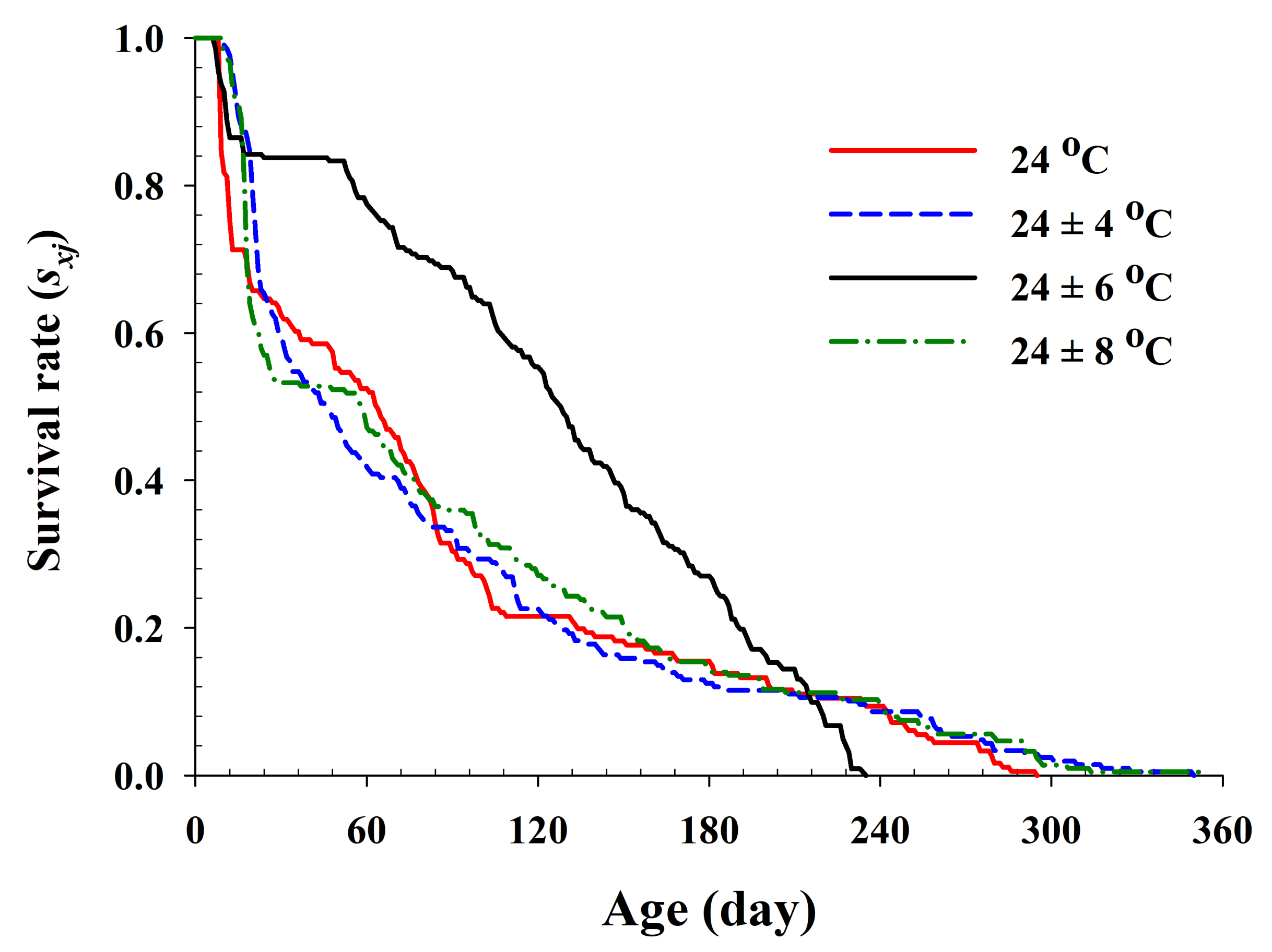
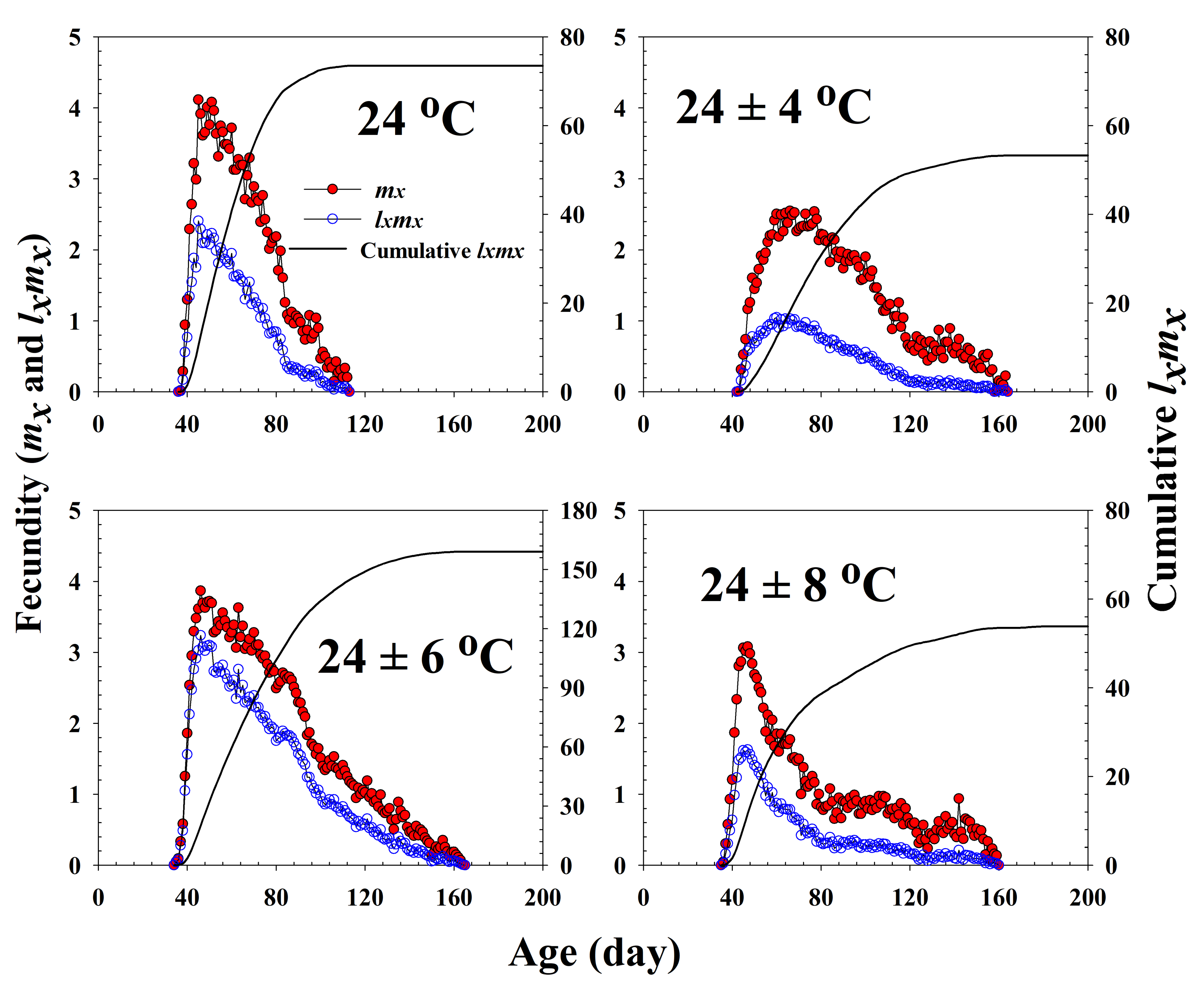

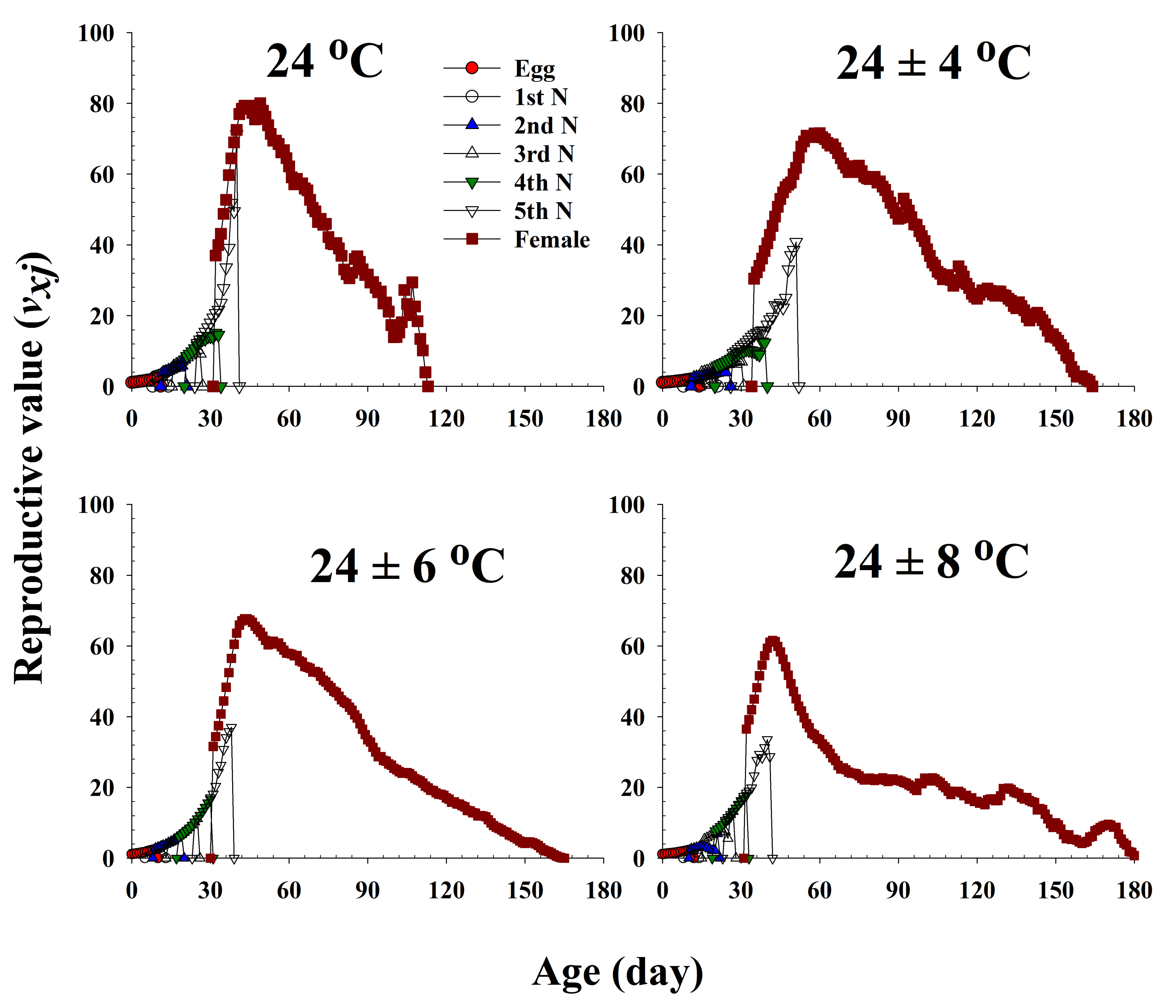
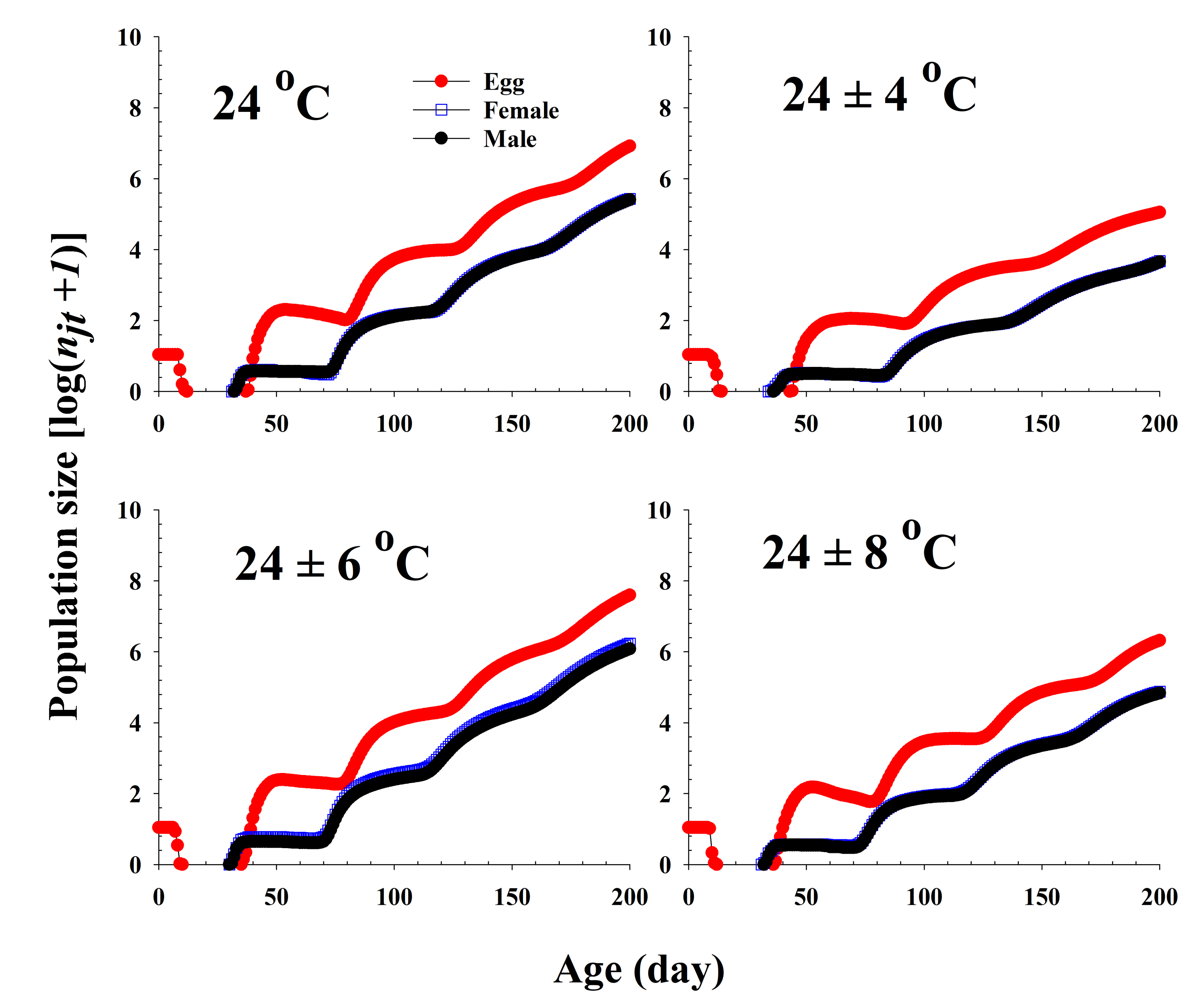
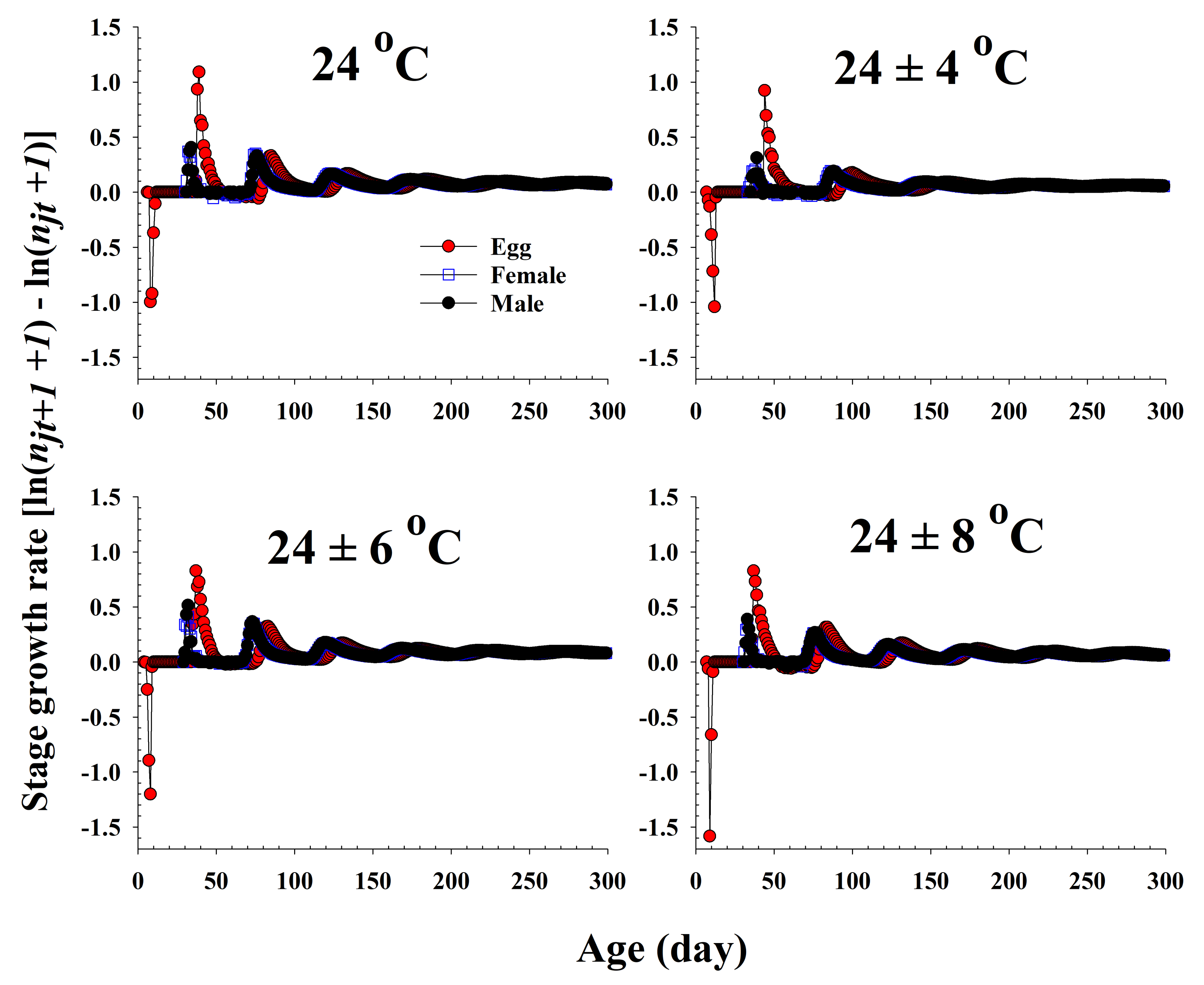
| Parameters | Temperatures (°C) | |||
|---|---|---|---|---|
| 24 | 24 ± 4 | 24 ± 6 | 24 ± 8 | |
| Egg P | 9.4 ± 0.04c (145) | 11.4 ± 0.08a (201) | 8.0 ± 0.05d (208) | 10.1 ± 0.03b (209) |
| 1st instar P | 3.0 ± 0.02b (129) | 3.2 ± 0.04a (181) | 2.9 ± 0.03c (192) | 2.4 ± 0.03d (194) |
| 2nd instar P | 5.6 ± 0.09b (119) | 6.1 ± 0.07a (136) | 5.3 ± 0.003c (187) | 4.9 ± 0.07d (131) |
| 3rd instar P | 5.0 ± 0.07b (116) | 5.5 ± 0.09a (124) | 4.8 ± 0.05b (187) | 5.0 ± 0.07b (119) |
| 4th instar P | 5.2 ± 0.06c (110) | 6.1 ± 0.10a (110) | 5.3 ± 0.002bc (186) | 5.5 ± 0.06b (114) |
| 5th instar P | 7.1 ± 0.07d (110) | 9.1 ± 0.20a (110) | 7.5 ± 0.04c (186) | 7.8 ± 0.06b (114) |
| Pre-adult P | 35.4 ± 0.17b (110) | 41.4 ± 0.35a (110) | 34.0 ± 0.13c (186) | 35.6 ± 0.18b (114) |
| Adult female P | 40.7 ± 2.74c (60) | 62.0 ± 5.76b (54) | 91.8 ± 4.05a (110) | 78.5 ± 6.14a (59) |
| Adult male P | 147.8 ± 10.50a (50) | 120.5 ± 13.26a (56) | 137.9 ± 6.62a (76) | 140.2 ± 12.42a (55) |
| APOP | 5.3 ± 0.11b (56) | 9.9 ± 0.71a (54) | 5.3 ± 0.09b (109) | 5.7 ± 0.78b (59) |
| TPOP | 40.8 ± 0.29b (56) | 51.1 ± 0.92a (54) | 39.5 ± 0.19c (109) | 41.2 ± 0.82b (59) |
| Oviposition P | 35.4 ± 2.24c (60) | 41.5 ± 4.42bc (54) | 69.6 ± 2.97a (110) | 44.9 ± 2.49b (59) |
| Fecundity (eggs/female) | 221.6 ± 15.88b (60) | 205.2 ± 23.54b (54) | 321.1 ± 11.09a (110) | 195.2 ± 9.76b (59) |
| Parameters | Temperatures (°C) | |||
|---|---|---|---|---|
| 24 | 24 ± 4 | 24 ± 6 | 24 ± 8 | |
| Pre-adult survival rate (%) | 60.8 ± 0.03b (181) | 52.8 ± 0.03b (208) | 83.8 ± 0.02a (222) | 53.2 ± 0.03b (214) |
| First age survival rate <50% | 63.1 ± 7.07b (181) | 45.3 ± 6.34b (208) | 127.7 ± 5.31a (222) | 52.4 ± 13.75b (214) |
| Net reproductive rate (Ro) | 73.4 ± 9.37b (181) | 53.2 ± 8.67b (208) | 159.1 ± 12.07a (222) | 53.8 ± 6.53b (214) |
| Intrinsic rate of increase (r) | 0.08 ± 0.002b (181) | 0.05 ± 0.002d (208) | 0.09 ± 0.001a (222) | 0.06 ± 0.002c (214) |
| Finite rate of increase (λ) | 1.08 ± 0.002b (181) | 1.05 ± 0.002d (208) | 1.09 ± 0.001a (222) | 1.07 ± 0.002c (214) |
| Mean generation time (T) | 55.7 ± 0.63c (181) | 69.8 ± 1.14a (208) | 59.1 ± 0.43b (222) | 57.2 ± 0.91bc (214) |
| Proportion of female individuals (Nf/N) | 33.2 ± 0.03b (181) | 26.0 ± 0.03b (208) | 49.6 ± 0.03a (222) | 27.6 ± 0.03b (214) |
| Proportion of male individuals (Nm/N) | 27.6 ± 0.03ab (181) | 27.0 ± 0.03ab (208) | 34.2 ± 0.03a (222) | 25.7 ± 0.02b (214) |
| Proportion of N-type individuals (Nn/N) | 39.2 ± 0.03a (181) | 47.1 ± 0.03a (208) | 16.2 ± 0.03b (222) | 46.7 ± 0.03a (214) |
Publisher′s Note: MDPI stays neutral with regard to jurisdictional claims in published maps and institutional affiliations. |
© 2022 by the authors. Licensee MDPI, Basel, Switzerland. This article is an open access article distributed under the terms and conditions of the Creative Commons Attribution (CC BY) license (https://creativecommons.org/licenses/by/4.0/).
Share and Cite
Ahn, J.J.; Choi, K.S. Population Parameters and Growth of Riptortus pedestris (Fabricius) (Hemiptera: Alydidae) under Fluctuating Temperature. Insects 2022, 13, 113. https://doi.org/10.3390/insects13020113
Ahn JJ, Choi KS. Population Parameters and Growth of Riptortus pedestris (Fabricius) (Hemiptera: Alydidae) under Fluctuating Temperature. Insects. 2022; 13(2):113. https://doi.org/10.3390/insects13020113
Chicago/Turabian StyleAhn, Jeong Joon, and Kyung San Choi. 2022. "Population Parameters and Growth of Riptortus pedestris (Fabricius) (Hemiptera: Alydidae) under Fluctuating Temperature" Insects 13, no. 2: 113. https://doi.org/10.3390/insects13020113
APA StyleAhn, J. J., & Choi, K. S. (2022). Population Parameters and Growth of Riptortus pedestris (Fabricius) (Hemiptera: Alydidae) under Fluctuating Temperature. Insects, 13(2), 113. https://doi.org/10.3390/insects13020113





